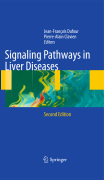
Signaling Pathways in Liver Diseases, 2nd edition focuses on signaling pathways which are particularly important in liver diseases. Recent progress broughthepatology to new frontiers. The increasing frequency of surgery on steatoticand cirrhotic liver obliges liver surgeons and hepatologists to understand the molecular mechanisms at play in these situations and how they can be influenced. Better comprehension of the cellular mechanisms participating in liver regeneration, hepato-cellular apoptosis and ischemia/reperfusion inquiry is mirrored by a dramatic increase in complexity. The number and scope of publications is intimidating and difficult for busy individuals to extract a coherent framework. This book will serve as a source of information facilitating the reading of the literature and the planning of trials. Translational medicine implies knowledge of the molecular targets for novel therapeutic strategies. It willfurthermore stimulate more research and lead to better exchange between the laboratory, the clinical ward and the operation room. INDICE: Hepatocytes.- Biliary Epithelial Cells.- Stellate Cells.- Kupffer Cells.- Endothelial Cells.- Extracellular Matric.- Platelets A New Cell Type In Liver Physiology.- Immunology Cells.- Toll Like Receptors.- TNF-Alpha.- Fas/FasL.- Interferon Signalling.- NFkB.- JNK In Liver Diseases.- Insulin Pathway.- Akt .- TOR Signalling.- AMP-Kinase.- ER Stress Signalling.- PPARs.- Bile Acid and Nuclear Receptors.- PXR and CAR.- p53.- Myc Pathway.- Wnt/Beta-Catenin.-Shh Pathway.- HIF.- VEGF.- Apoptosis and Mitochondria.- Calcium Signaling.- Signaling of Hepatitis B Virus.- Signaling of Hepatitis C Virus.- MicroRNAs.- Hepatic Clock.- Index.
- ISBN: 978-3-642-00149-9
- Editorial: Springer
- Encuadernacion: Cartoné
- Páginas: 578
- Fecha Publicación: 14/10/2009
- Nº Volúmenes: 1
- Idioma: Inglés
